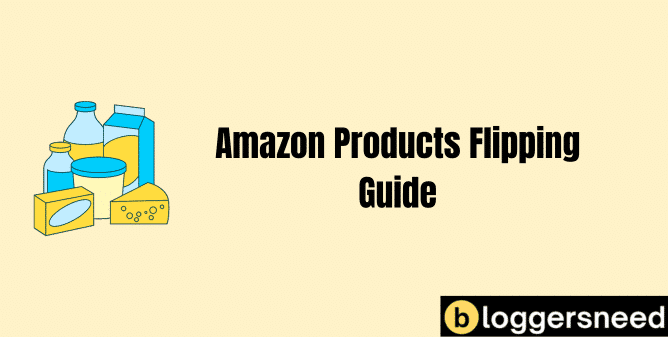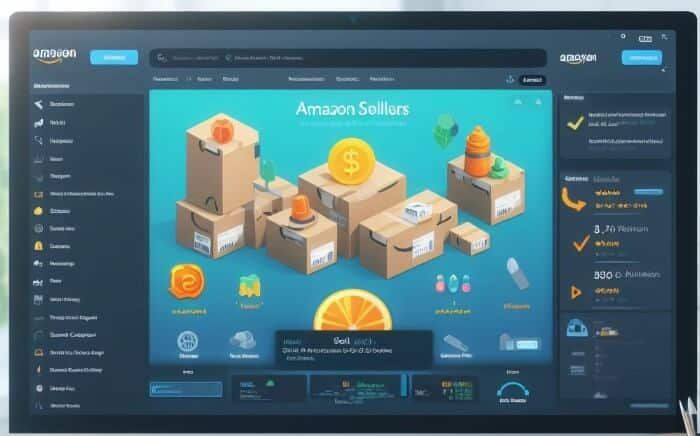
Flipping items on Amazon is known to be a profitable venture.
However, many people online struggle to find an accessible guide to master this skill.
That’s why we’ve decided to create this guide, in which you’ll learn how to identify profitable products, the best places to purchase them, and how to sell them on Amazon for maximum profit.
Additionally, we have discussed some SEO strategies to optimize your store and fully leverage its potential.
Let’s dive in.
Table of Contents
What is Flipping Items on Amazon?
You’ve likely heard the buzz about flipping items on Amazon, a process where you can turn a tidy profit by reselling products at a higher price.
It’s not just about the buy low, sell high mantra; you’ll need to grasp the intricacies of Amazon’s marketplace to succeed.
Let’s explore the upsides and downsides of this venture to see if it’s the right fit for you.
Pros
- You can buy the product for low price and sell it for high price.
- Since you’re flipping product, it cuts your production cost.
- Amazon FBA simplifies this process by handling storage, packing, and shipping for you. This convenience means you can focus on finding profitable products and perfecting your pricing strategies.
Cons
- You’re dealing with the unpredictability of resale markets and the inherent competition.
- You’ve got to navigate through fluctuating price differences, which can erode your margins. Moreover, the fees associated with maintaining an Amazon seller account can add up quickly, eating into your earnings.
- Finding a regular supplier is tough and finding the product with good quality is also risk, since you’re not producing it.
- You’ll also need to manage inventory effectively, ensuring you don’t overstock items with slow turnover rates.
Understanding the Amazon Marketplace Ecosystem
Before you start flipping items on Amazon, it’s essential to grasp the intricacies of its marketplace ecosystem, which includes a variety of seller types and fulfillment options. Here’s what you need to know:
- Amazon Sellers: You’ll be joining a community of individual and professional sellers. Use the Amazon Seller app to track sales and manage your business on the go.
- FBA Sellers: Consider using Fulfillment by Amazon (FBA) to store your products in Amazon’s fulfillment centers. They handle shipping, customer service, and returns.
- Online Arbitrage: This involves buying products online at a lower price and selling them at a higher price on Amazon.
- Marketplace Dynamics: Stay informed about Amazon’s algorithms and seller policies, as they significantly impact your sourcing and pricing strategies.
Understanding these elements is pivotal for successful flipping on the Amazon marketplace.
Finding Profitable Items to Flip

Often, the key to a successful flip on Amazon is pinpointing items that consistently sell well yet face limited competition. You’ll want to source products that strike the right balance between high demand and low competition.
Tactical arbitrage can be a game-changer here, helping you scan through online stores for clearance items that can be resold at a profit on Amazon.
Here’s a quick guide to help you identify potential flips:
| Factor | Why It Matters |
|---|---|
| Sales Rank | Indicates high demand |
| Competition | Fewer sellers mean less rivalry |
| Seasonal Trends | Capitalize on timely demand |
Stay informed and agile, and you’ll find those hidden gems that can turn into lucrative flips. Keep your eyes peeled for those opportunities, and you’ll master the art of flipping on Amazon.
Analyzing Market Demand and Competition

You’ll need to gauge the market’s vitality by analyzing Amazon’s sales data and competition levels to ensure your flips meet the demand without getting lost in saturation. Here’s how you can break it down:
- Check Sales Rankings: Use tools like Helium 10 to decipher Amazon’s sales rankings and gauge market demand for potential flip items.
- Review Competition: Look at the number of listings and seller ratings for similar products to assess how crowded the market is.
- Analyze Profitability: Determine your potential profit by examining pricing trends and factoring in Amazon fees.
- Monitor Trends: Keep an eye on market fluctuations to stay ahead of the game and adjust your flipping strategy accordingly.
Armed with this data, you’re better equipped to pick items that promise a higher chance of flipping success.
Sourcing Products for Amazon Flipping
To effectively flip items on Amazon, you’ll need to secure a steady flow of products at competitive prices. Start by exploring websites that offer bulk purchases at a discount, ensuring you’re getting the best deal possible.
Remember to check the authenticity and quality of products to maintain a reputable seller status.

Website to Buy Products in Bulk & Cheap
Finding the right websites to buy products in bulk for Amazon flipping can make or break your business. You’ll want to check out Alibaba and AliExpress, as they’re giants in the wholesale space, offering a vast array of items at low prices.
With these platforms, you can source products cheaply and in large quantities, setting the stage for a profitable flip on Amazon.
Alibaba
When sourcing products for Amazon flipping, Alibaba is your go-to marketplace for purchasing items in bulk at low costs. Here’s how to maximize your profits:
- Look for products with a high price difference between wholesale Alibaba prices and retail stores.
- Order samples to verify quality.
- Calculate potential Amazon FBA business margins.
- Purchase in volume to reduce per-item cost and boost profit.
Aliexpress
You’ll find an array of affordable bulk purchase options on AliExpress, another significant platform for sourcing products to flip on Amazon.
| Feature | Benefit |
|---|---|
| Dropshipping Support | Simplifies logistics for your Amazon store |
| Wholesale Extension | Access bulk pricing at your fingertips |
| Free Amazon Seller | Leverage your Amazon business account with minimal start-up costs |
AliExpress offers a seamless bridge to a profitable flipping business with its vast product range and integrated features.
Calculating Costs and Potential Profits

Before flipping items on Amazon, you’ve got to crunch the numbers to ensure your chosen items can turn a profit after accounting for all associated costs. Here’s how to calculate your potential profits:
- Purchase Price: Determine the cost of acquiring the item, considering bulk discounts or individual purchase prices.
- Amazon Fees: Use Amazon’s FBA calculator to estimate the fees, which include fulfillment and referral charges.
- Shipping and Taxes: Add the cost of shipping the items to Amazon’s warehouse and any applicable taxes.
- Competitive Pricing: Research the current price of similar products on Amazon to set a competitive price.
Your potential profit lies in the difference between your total investment and the selling price after subtracting all expenses.
Crafting Effective Product Listings for Flipped Items
Crafting compelling product listings is crucial to your success in flipping items on Amazon. To thrive in this competitive online marketplace, start with high-quality images that grab attention and spark interest.
Your product descriptions should be rich in detail, clearly explaining what you’re selling while incorporating relevant keywords to boost SEO. This isn’t just about listing features; it’s about selling the experience and benefits that come with the right products.
Highlight what makes your flipped items unique and why they’re worth the purchase. Remember, clarity and conciseness are your allies.
Every word in your product listings should serve a purpose, driving potential buyers closer to making a decision, and ultimately, contributing to your Amazon flipping triumph.
Pricing Strategies for Maximum Profit
To maximize your earnings when flipping items on Amazon, it’s essential to adopt a pricing strategy that reflects both market demand and your competitors’ pricing. Here’s how to set your prices strategically:
- Employ Dynamic Pricing: Be agile with your pricing. Adjust prices as market conditions change to stay competitive without sacrificing your profit margins.
- Analyze Your Competition: Regularly monitor the prices set by other sellers for similar items. If you notice a trend, consider whether you should follow suit or differentiate.
- Consider Your Costs: Always factor in your costs, including Amazon fees, when setting a low price to ensure you don’t run at a loss.
- Use Your Seller Account Tools: Amazon provides tools within your seller account to help track and adjust your pricing strategies efficiently.
Stay informed and proactive with these tips, and you’ll optimize your Amazon flips for maximum returns.
Enhancing Visibility with Amazon SEO Techniques
You’ll increase your product’s chance of being seen by mastering Amazon SEO techniques that push your listings up the search results page.
Start by optimizing your product titles and descriptions, weaving in relevant keywords without sacrificing clarity. Remember, the Amazon.com marketplace is vast, and standing out is key to driving sales.
Encouraging positive reviews and ratings is also crucial; they serve as social proof and can significantly enhance visibility. Don’t overlook the power of Amazon ads and promotions—these tools can give your listings the extra push they need.
Scaling Your Amazon Flipping Business
As your Amazon flipping business grows, you’ll need to implement strategies to scale up effectively and sustainably. Here are four key steps:
- Diversify Your Inventory: Don’t put all your eggs in one basket. Flip a mix of power tools, vintage items, and other profitable goods to spread risk and boost sales.
- Invest in Automation: Utilize software that streamlines your operations, from sourcing to listing, to save time and reduce errors.
- Leverage Amazon’s Resources: Take advantage of Amazon warehouse services to handle storage and fulfillment, freeing you to focus on scaling your business.
- Expand Marketplaces: Don’t limit yourself. Sell on additional platforms such ebay, Etsy, etc to reach a wider audience and increase potential revenue.
These steps can propel your flipping endeavors to new heights.
Avoiding Common Pitfalls in Amazon Flipping
Other than flipping products on Amazon you must consider to follow the Amazon rules and restrictions.
Unlike flipping houses, where the market conditions vary widely, Amazon’s platform has a set of strict rules that can lead to suspension if not followed. It’s not just about finding deals at garage sales or retail shops; it’s also about smart strategizing.
Here’s a quick guide to avoid common mistakes:
| Pitfall | Solution |
|---|---|
| Policy Violations | Stay updated on Amazon’s guidelines. |
| Engaging in Price Wars | Focus on value, not just the lowest price. |
| Ignoring Market Changes | Adapt by monitoring trends on eBay etc. |
| Overlooking Shipping Costs | Factor in these costs to maintain margins. |
Keep these tips in mind to ensure your flipping journey is smooth and successful.
Tools and Resources for Amazon Sellers

To enhance your Amazon flipping strategy, you’ll need to tap into a suite of specialized amazon seller tools and resources that can streamline your operations and increase profitability. Here’s a quick guide:
- Inventory Management Tools: Use software like Helium10 or Carbon6 to keep an eye on your stock levels, especially when sourcing from retail stores.
- Repricing Tools: Investing in tools that adjust your prices automatically can help you stay competitive without constant monitoring.
- Analytics: Platforms like SellerSprite offer valuable insights into market trends, helping you pick new products with high flipping potential.
- Educational Resources: Don’t underestimate the power of Amazon’s Seller Central, forums, webinars, and seller communities for staying informed about the latest flipping strategies and updates.
Conclusion
I hope now you know how to flip items on Amazon strategically by buying the products on low price and selling it.
Try to understand the flipping business and always watch the trends and buy profitable products from wholesale sellers.
Now, go and work for your success.
Affiliate Disclosure: Some of the links in this post are affiliate links, which means I may earn a small commission if you make a purchase through those links. This comes at no extra cost to you. Thank you for your support!
